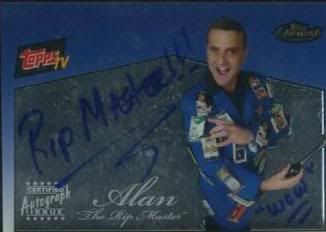Lee Elia always reminded me of "Red" from the Tube Bar tapes. (Very NSFW!)
Oh yeah, here's some cards.








short set: 146 of 425Black Backs: 25 (one-per-pack)
Short Prints: 8 of 75 (1:3)
 One box of 1995 Upper Deck Series One Hobby (Paid $35)
One box of 1995 Upper Deck Series One Hobby (Paid $35)Base Set: 208 of 225 (92.44%)
166 Doubles
18 Triples
Inserts:
35 Special Editions
1 Special Edition Gold: K. Foster
1 Hobby Predictor: A. Gonzalez
1 Steal of a Deal: D. Eckersley
2 Checklists: K. Rogers, G. Maddux
One word can best describe 1995 Upper Deck baseball: simple. Considering what came before, and what was about to come, the '95 UDs were extremely minimalist. Just a full-bleed photo, the player's name and team (in very small type), a UD logo, and that's it. Not exactly the harbinger on the "foil-stamp the shit out of everything" fronts that was to come in the late-90s.
 '95 was the first year that the UD flagship did NOT open up with the Star Rookies. Instead, they were shifted to the back end of the first series, and merged with a second batch of SRs that opened up Series Two. (A third-year Derek Jeter and a second-year A-Rod both make cameos in the SR subset.) In their place, the Top Prospects open up the set. The was the final year for the TPs, and the only one of note is a third-year card of Nomar Garciaparra. There are also second-year cards of such Hobby flameouts Ruben Rivera, Paul Wilson, and true "Rookie Cards" are of Karim Garcia, Raul Casanova, and Nolan Ryan's son Reid Ryan. Another notable base card is of Michael Jordan being interviewed by a already-on-his-seventh-Budweiser-looking Harry Caray.
'95 was the first year that the UD flagship did NOT open up with the Star Rookies. Instead, they were shifted to the back end of the first series, and merged with a second batch of SRs that opened up Series Two. (A third-year Derek Jeter and a second-year A-Rod both make cameos in the SR subset.) In their place, the Top Prospects open up the set. The was the final year for the TPs, and the only one of note is a third-year card of Nomar Garciaparra. There are also second-year cards of such Hobby flameouts Ruben Rivera, Paul Wilson, and true "Rookie Cards" are of Karim Garcia, Raul Casanova, and Nolan Ryan's son Reid Ryan. Another notable base card is of Michael Jordan being interviewed by a already-on-his-seventh-Budweiser-looking Harry Caray.
There are two differences between the hobby and retail version of '95 UD, and one of which is the one-per-pack insert. In retail packs, you get one Electric Diamond card per pack -- which is a traditional one-per-pack parallel. Hobby packs though, came with their own one-per-pack insert: The Special Editions. The SEs were unique, in that they are a pretty comprehensive set onto itself. At 270 cards (135 in each series), it remains one of the largest non-parallel insert sets every produced, and remains a challenging set to try to complete -- even a dozen years later.
The other difference between hobby and retail has to do with the Predictor inserts. The Predictors were interactive game cards that could be redeemed if the player shown won an award of some sort. The idea for on the interactive insert wasn't new -- 1994 Leaf had the popular MVP Contenders inserts -- but with the effects of a devastating strike still lingering, and with the overall "copycat" mentality of mid-90s era The Hobby, card companies were trying anything and everything they could to drum up sales. There are 40 Hobby Predictors in all (20 American Leaguers in the first series, and 20 National Leaguers in the second), and 60 Retail Predictors (30 AL and 30 NL).
Rounding out the set are the 15 Steal of a Deal inserts, and five checklists -- which, as was the custom of the time, were seeded into packs as inserts.
Technically, there are no autogamers; however, there was a wrapper redemption offer good for for one of 8000 serial-numbered autographed Roger Clemens jumbo cards. This offer has long since expired.
The Bottom Line
Collation was typical for a mid-90s Upper Deck product. It yielded 92% of the base set, and a healthy stack of tradeable doubles. The inserts ran as advertised.
